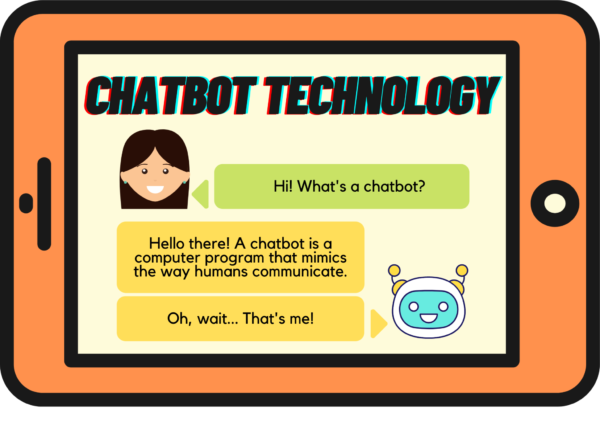Chatbot Technology: Everything You Need to Know
If you’ve been on the internet for the past couple of years, you probably already have some experience dealing with chatbot technology.
Chatbots are software apps designed to serve as a customer’s first touchpoint with a brand. They are usually found on e-commerce websites, initiating interactions with potential customers.

It’s been clear since their introduction that chatbots will be a huge part of the e-commerce industry. According to Gartner, 70% of customer interactions will involve chatbots, machine learning, and mobile messaging technologies by the year 2022.
What is a Chatbot?
A chatbot can be technically defined as a robot that communicates with people via chat. A chatbot can answer questions, carry conversations, and even perform computer actions.
4 Reasons Why You Need a Chatbot For Your Business
You may be having second thoughts about putting in the time and resources to building a chatbot. So, we’ll list here every single reason why you need a chatbot for your business.
Benefit #1: Chatbots Can Help With Branding
As with every business, it pays to make a great impression. First interactions can affect how customers perceive your brand.
A chatbot’s personality can help you build your brand. Once it’s up and running, a chatbot allows customers to learn more about your company without any extra effort on your part. So, when you’re planning to create a brand strategy, don’t forget to include chatbots!
Benefit #2: Chatbots can Provide Instant Feedback
A chatbot’s instant replies mean that no customer is left waiting for simple answers to simple questions. Chatbots are available 24/7, even when call center agents and chat representatives aren’t. Chatbots can reply instantly to multiple customers at once, and no one has to wait in line.
If a chatbot’s answer doesn’t suffice, it can offer to connect your customer to customer service. Outside working hours, a chatbot can allow your customer to leave a message for customer service to reply at a later time.
Benefit #3: Chatbots Can Help Close Sales
Timely delivery of information can help close sales. If a bot can provide your customer with the information they need, you’re more than likely to close a sale. Chatbots can provide information, offer assistance, and even suggest alternatives.
Benefit #4: Chatbots Can Help Cut Costs
Developing chatbots for businesses used to be so difficult. In the past, whole teams of developers took months and years to develop acceptable chatbots. Now, one programmer can make a simple chatbot within hours or days. And as with every business, time saved is money saved!
You can also save on operational costs with chatbots. They reduce the need for actual representatives to man the lines.
4 Different Types of Chatbots and How They’re Used
Businesses and organizations use chatbots to engage potential customers. But, there are many other applications for chatbot technologies. You might want to choose the right type of bot for your business model.
1. Menu Chatbots
Menu chatbots are also called button-based chatbots. You converse with them by clicking buttons that serve as your choices, just like choosing a menu item.
A menu chatbot works like a decision tree. To find the answers, you need to ask the right questions by choosing the right options.
As you probably can tell, they aren’t very smart chatbots. Their answers heavily depend on scripts provided by their developer. They’re easy to build though, and they’re still pretty effective in reducing the number of customers needing actual customer representatives.
How they’re used: Menu chatbots are typically used for FAQs and simple food orders.
2. Keyword Recognition-Based Chatbots
Keyword recognition-based chatbots use NLP and AI chatbot technology. These chatbots try to listen to and understand what the customers are trying to say by using keyword recognition. This means that their replies will depend on keywords, closely related words, or keyword synonyms.
Though they may seem smart, they lose their credibility when faced with redundancies and multiple keywords.
How they’re used: Keyword recognition-based chatbots are mostly used with menu chatbot technologies. This combination allows customers to choose options or type in customized responses.
3. Rule-Based Chatbots
Rule-based chatbots are also called linguistic-based chatbots. That’s because they make conversation using clues found in a customer’s replies. Clues and conditions are based on word orders, context, and synonyms.
Rule-based chatbot developers will spend a lot of time defining the rules and conditions that will garner a set of responses. It’s also the developers’ jobs to predict the most common questions or queries, so the chatbots can “understand” well enough to reply.
How they’re used: Rule-based chatbots are very specific. They’re highly recommended for providing human-like customer service.
4. ML Chatbots
ML or contextual chatbots are powered by machine learning technologies. ML chatbots make use of AI and machine learning to remember conversations and learn from them. Unlike every other chatbot in this list, a contextual chatbot can improve itself over time.
The only limit to a machine learning chatbot is training data. Though smart enough to learn new things, training chatbots to discern what’s right and wrong still falls on their developers.
How they’re used: ML chatbots are widely used in food-ordering systems and other businesses where user preference is a big factor.
4 Examples of How Chatbots Can Solve Business Problems
Businesses from different industries can use chatbots. E-commerce, banking, real estate, travel, hospitality, food, education, logistics, and many other industries can benefit from chatbots.
Chatbot technology can also support other departments aside from customer service. They can be valuable tools for marketing, sales, IT help desks, and HR too.
But, how do chatbots help with common business problems?
Example #1: Support Bots
This is the most common type of chatbot. Support bots are designed to assist customers, walk them through processes, and help them solve specific problems. Support chatbots are used for FAQs, food ordering, customer service, and product recommendation.
Example #2: Assistant Bots
Alexa, Siri, and Cortana are assistant bots. They can be classified as chatbots too since we can ask them questions and converse with them through chat. Assistant bots are popular for assisting users with a range of different functions like searching the web, ordering food, calling emergency services, booking appointments, setting reminders, and more.
Example #3: Skill Bots
Skill bots can listen or wait for commands. They then carry out the tasks either instantly or at a later, specified time. Skill chatbots like the Google Assistant can play videos, text people, find directions, and take your photo. You can even teach them your routines.
Example #4: Information Bots
Information bots can help gather or distribute information. News bots can send timely notifications to subscribers about relevant news. Research bots can help extract relevant information from one or multiple sources.
In a Nutshell
A few years ago, people thought chatbots were just a gimmick. Though they had potential, few believed that they could evolve this much in a matter of a few years.
Now, chatbots can help with brand image, customer service, sales, cost-cutting, and more. They are considered important business tools. They help companies across different departments and industries.
The evolution of chatbots will continue as long as there’s still room for improvement for underlying technologies like ML, AI, and NLP. Chatbots are just getting started.
















